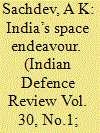| Srl | Item |
| 1 |
ID:
138584


|
|
|
|
|
| Summary/Abstract |
As in the case of the US, for India too, satellite data and its associated connectivity touch every aspect of daily life.
|
|
|
|
|
|
|
|
|
|
|
|
|
|
|
|
| 2 |
ID:
120645


|
|
|
|
|
| Publication |
2012.
|
| Summary/Abstract |
The 2007 US National Research Council Decadal Survey for Earth Science and Applications from Space was the first consensus perspective produced by the US Earth Science community of the relative priorities among a sequence of 17 satellite missions over the course of the next decade. However, the Decadal Survey only captured the perspective of the science community, leading to questions about the inclusion of broader priorities from constituent communities and stakeholders. We present a stakeholder value network analysis for the NASA/NOAA Earth Observation Program. The analysis includes a rigorous articulation of the needs and objectives of 13 major stakeholders and a complete stakeholder value network with 190 individual "value flows" that capture the interactions between all the stakeholders. It produces a novel stakeholder map, graphically indicating the outputs most likely to create a lasting Earth Science program. The most important value loops and program outputs are used to derive a set of high-level program goals that suggest what NASA and NOAA should do, as well as how they should conduct business. The analysis concludes that international partnerships represent a strong potential partner for certain science missions with greater potential value delivery than currently-prioritized efforts with defense stakeholders and concludes that weather and land-use missions, in addition to climate missions, should be given highest priority; water, human health, and solid Earth missions should be given lower priority based on each science category's potential for delivering value to the entire stakeholder network.
|
|
|
|
|
|
|
|
|
|
|
|
|
|
|
|
| 3 |
ID:
138226


|
|
|
|
|
| Summary/Abstract |
The U.S. Government faces acute budgetary deficits and national debt problems in the Obama Administration's second term. These problems have been brought about by decades of unsustainable government spending affecting all federal agencies including the National Aeronautics and Space Administration (NASA). An outgrowth of this fiscal profligacy is the presence of wasteful and duplicative programs within NASA that prevent this agency from achieving its space science and human spaceflight objectives. These programs occur due to mismanagement of these programs by NASA and from the creation of these programs by the U.S. Congress and congressional committees. This occurs because congressional appropriators tend to be more concerned with economically enhancing their states and districts and promoting their reelections instead of providing effectively targeted funding and oversight of their programs to ensure they meet national space policy goals and provide tangible value for taxpayers. This work will examine recent examples of wasteful and duplicative NASA programs and suggest ways to improve their utility.
|
|
|
|
|
|
|
|
|
|
|
|
|
|
|
|